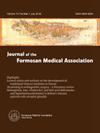儿科饮食评估工具-10》繁体中文版的翻译和验证。
IF 2.6
3区 医学
Q1 MEDICINE, GENERAL & INTERNAL
引用次数: 0
摘要
背景:/目的:小儿进食评估工具-10(Pedi-EAT-10)是由护理人员管理的主观问卷,用于评估儿童吞咽和进食障碍:/目的:儿科进食评估工具-10(Pediatric Eating Assessment Tool-10,Pedi-EAT-10)是一份由护理人员管理的主观问卷,用于评估儿童吞咽和进食障碍。本研究将 Pedi-EAT-10 翻译成繁体中文,并测试了翻译版本的信度和效度:方法:Pedi-EAT-10由专家翻译成繁体中文,经讨论和测试后定稿。共招募了 168 名参与者,其中包括 32 名来自某三级医疗中心的吞咽困难儿童和 136 名来自该中心职工儿童关爱中心的健康对照者。所有参与者均由耳鼻喉科医生和言语病理学家进行评估。我们分析了Pedi-EAT-10翻译版的信度、效度和有效性,以确保它能用于识别小儿吞咽困难和喂养问题:繁体中文版 Pedi-EAT-10 具有较好的信度和效度,护理人员可以快速、轻松地完成。翻译后的 Ped-EAT-10 可作为评估是否需要进一步转诊和器械检查的一线工具。本文章由计算机程序翻译,如有差异,请以英文原文为准。
Translation and validation of traditional Chinese version of the pediatric eating assessment Tool-10
Background/Purpose
The Pediatric Eating Assessment Tool-10 (Pedi-EAT-10) is a caregiver-administrated subjective questionnaire for evaluating swallowing and feeding disorders among children. This study translated the Pedi-EAT-10 into Traditional Chinese and tested the translated version's reliability and validity.
Methods
Pedi-EAT-10 was translated into Traditional Chinese by experts and finalized after discussion and testing. A total of 168 participants, consisting of 32 children with dysphagia from a tertiary medical center and 136 healthy controls from its Children Care Center for Employees, were recruited. All participants were assessed by an otolaryngologist and speech-language pathologist. The reliability, validity, and efficacy of the translated Pedi-EAT-10 were analyzed to ensure it could be used to identify pediatric dysphagia and feeding problems.
Results
The Traditional Chinese version of the Pedi-EAT-10 had significant clinical discriminative validity between the dysphagia group and the control group (total score = 9.6 vs. 2.6, P < 0.001), acceptable test–retest reliability (intraclass correlation = 0.63), and excellent internal consistency (Cronbach's α = 0.91 for the entire cohort). The overall performance of the test for distinguishing children with dysphagia from normal controls was acceptable, and the area under the curve was 74.8% (sensitivity = 71.9%; specificity = 69.9%). The optimal cutoff score was ≥3 on the Youdex index.
Conclusion
The Traditional Chinese version of the Pedi-EAT-10 has fair reliability and validity and can be quickly and easily completed by caregivers. The translated Ped-EAT-10 can be used as a first-line tool for assessing the need for further referral and instrumental examination.
求助全文
通过发布文献求助,成功后即可免费获取论文全文。
去求助
来源期刊
CiteScore
6.50
自引率
6.20%
发文量
381
审稿时长
57 days
期刊介绍:
Journal of the Formosan Medical Association (JFMA), published continuously since 1902, is an open access international general medical journal of the Formosan Medical Association based in Taipei, Taiwan. It is indexed in Current Contents/ Clinical Medicine, Medline, ciSearch, CAB Abstracts, Embase, SIIC Data Bases, Research Alert, BIOSIS, Biological Abstracts, Scopus and ScienceDirect.
As a general medical journal, research related to clinical practice and research in all fields of medicine and related disciplines are considered for publication. Article types considered include perspectives, reviews, original papers, case reports, brief communications, correspondence and letters to the editor.

 求助内容:
求助内容: 应助结果提醒方式:
应助结果提醒方式:


